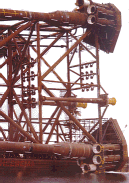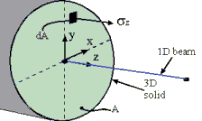Mixed Dimensional Coupling
Multi-Dimensional Coupling in Structural FE Analyses
The complex structure on the left is part of a facility used for offshore oil exploration. As can be seen, this is a framed structure. Frames are major structural components in many engineering structures. Applications vary from simple roof trusses to very complex structures such as the one illustrated.

The design and assessment of such components require consideration in strength, fatigue and fracture. The finite element method is used to simulate the behaviour of joints of complex geometry and welded joints with material heterogeneity. Analysis of complete frame structures is desirable so that load paths and magnitudes are computed correctly. Local stress-strain history, and failure modes and their locations can then be evaluated precisely.
Accurate predictions of static collapse behaviour for aging structures are essential so that reserve strength and likelihood of damage can be assessed. Full 3D elastic-plastic analyses are currently used to predict the responses of framed structures to the point of collapse. Due to the structural complexity, these impractical analyses result in long computing times and hence solution can only be obtained by using expensive supercomputers.
How can full analyses be carried out at reasonable cost ??
Substantial reductions in analysis times are achieved if idealisation techniques are employed. Due to discontinuities in geometry, loading and material behaviour, the highest stresses are produced at the joints of these structures, and hence failure and collapse usually occurs there. This non-linear behaviour requires full 3D analysis of each joint. Between the frame joints, the structures are long and slender, and can be replaced by beam elements. Beam elements are appropiate as they accurately represent the slender regions and are computationally efficient.

In order to achieve a state of compatibility of displacements and stress equilibrium at the junction or interface between the differing element types, it is important to integrate into the analysis some scheme for coupling the element types in a way that conforms with the theory of elasticity.
So How is Coupling Achieved ??
The work done at either side of the interface is equal, and so we can write:
- (force.distance)1d = (force.distance)3d
- (force.distance)1d = (stress.area.distance)3d

So the essence of the problem is to determine the correct stress distributions on the beam cross section. Extensive research at QUB has resulted in the correct evaluation of these stress distributions for arbitrary sections with any number of holes. The interaction of either side of the interface is achieved by using multi-point constraint equations. These equations are a way of connecting the two sides of the interface, so that when one side moves, the other side moves in a manner that is defined by the constraint equation.
By adopting the above idea, a marked reduction in analysis times can be achieved without any loss of accuracy. At the QUB Finite Element Research Group, focus in multi-dimensional coupling has been on 3D-1D coupling, the mathematical coupling of 1D beam elements to 3D continuum elements at a common interface. Coupling of elements of other dimensions have been considered, and have yet to be developed to full automation.
The beam to solid coupling procedures have been designed to facilitate multi-cellular sections at any orientation. They also include the ability to considir problems such as asymmetric bending and shear centers. Software has been developed to couple between beams and standard solid mesh types (3 noded & 6 noded triangular based 3D meshes, and 4 & 8 noded quadrilateral based 3D meshes). Click here for comparisons between the coupling technique developed at Queen's and the others that are available. Coupling of shells and solids has also been considered and developed to maturity. The procedure in generating the constraint equations again follows the aforementioned idea, i.e. equating the work done on either side of the dimensional interface. This method of coupling also proves itself to be applicable to problems involving composite laminates.